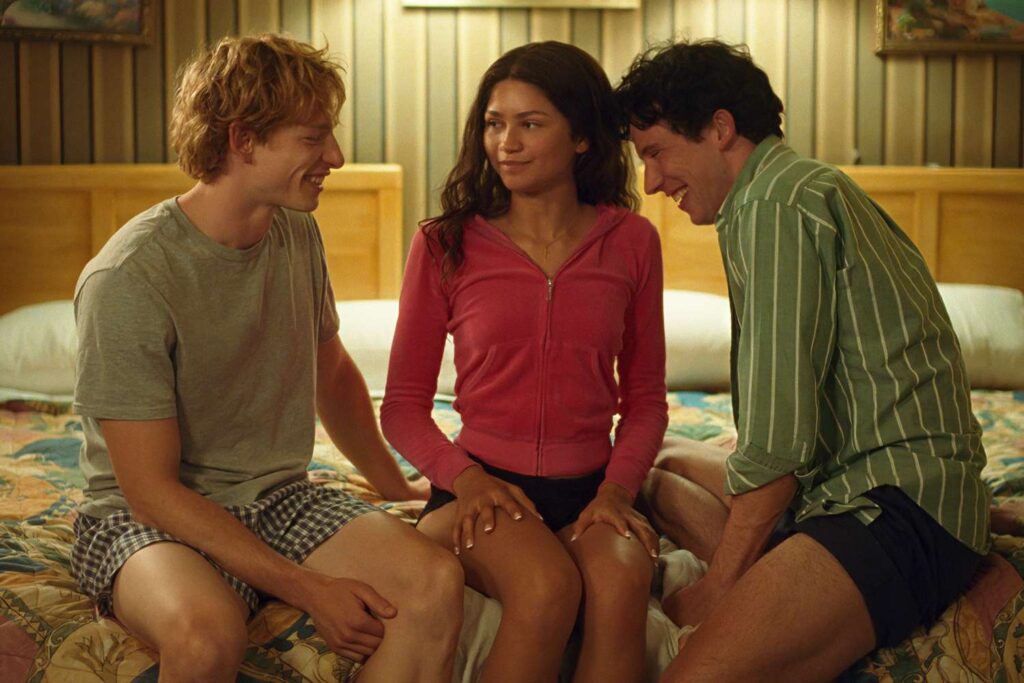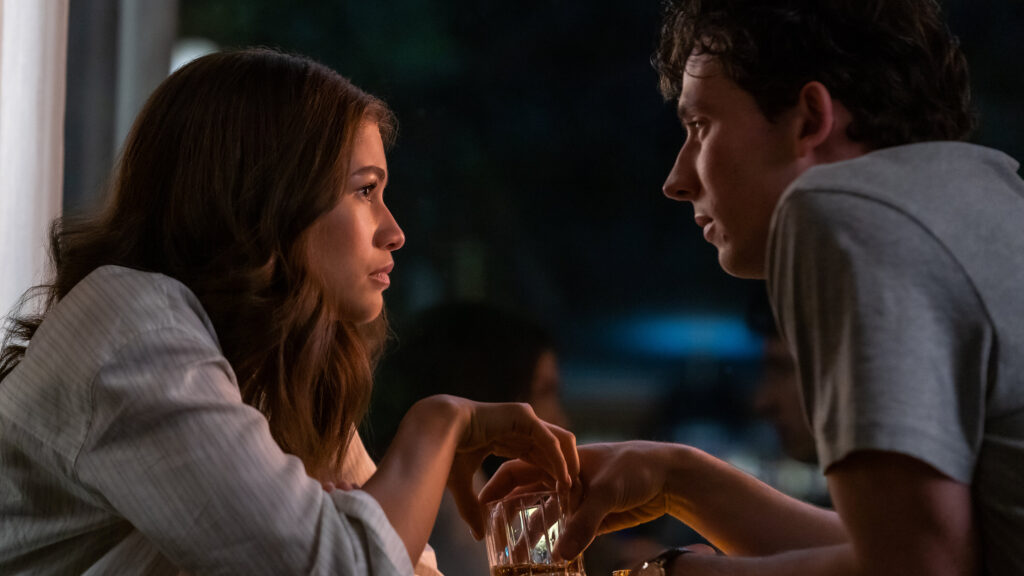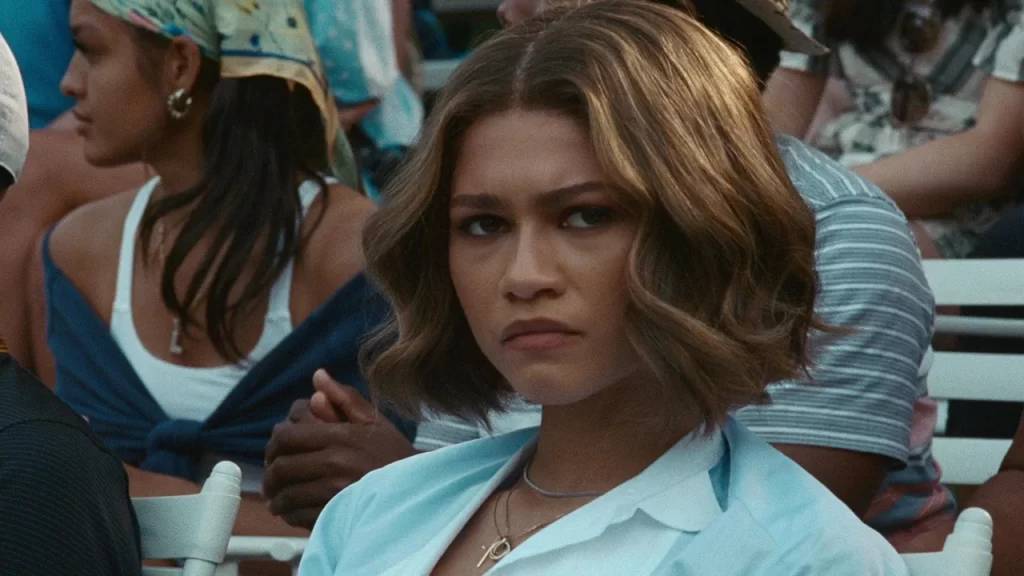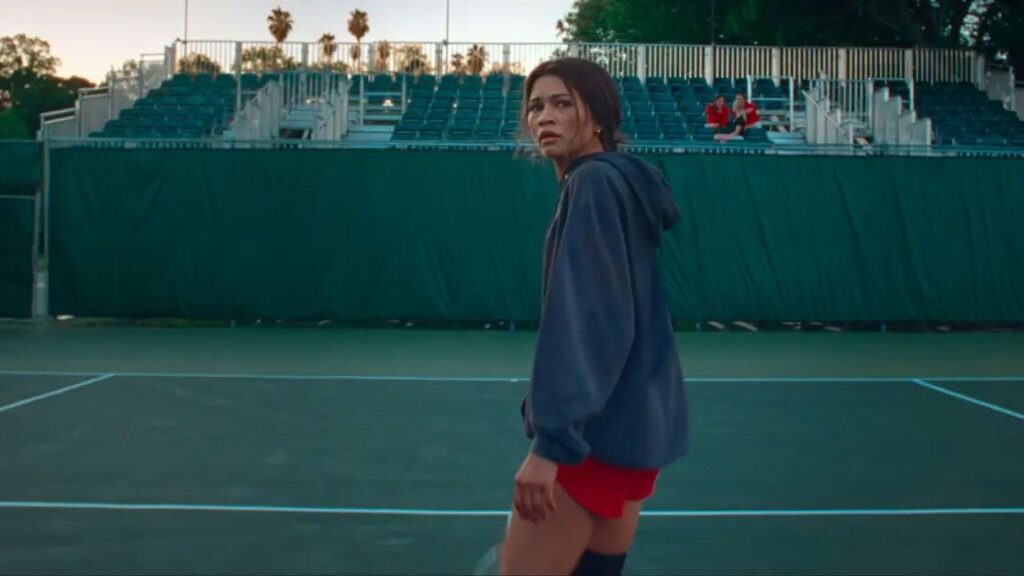
One of the first times we see Tashi Duncan (Zendaya) in Challengers, she’s clad only in black lingerie, the camera observing her backside in a manner somewhere between appreciative and exploitative. Empirically, it’s the most skin we see in the movie, yet from the characters’ point of view, it doesn’t represent Tashi at her most alluring. That comes later (really earlier, in the film’s chronology), when two admirers are watching her play tennis at the junior U.S. Open. As she trades ground strokes with an overmatched opponent, they gawk at her combination of power and grace. “Look at that fucking backhand,” one of them whispers, in an awed tone that suggests a repressed teenager who just caught a glimpse of Pamela Anderson in Playboy.
It seems diminishing to characterize Challengers, the riveting and ravishing new picture from Luca Guadagnino, as a sports movie. Sure, it follows the entwined lives of three gifted tennis players, but it’s more about their emotional cravings than their physical exploits. Yet it doesn’t treat tennis as mere window dressing. Instead, it captures the ineffable appeal of sports—the cathartic thrill of competition, the rigor of perfecting one’s craft, the blurry line between passion and professionalism—and binds it to the characters’ omnipresent hunger and vulnerability. There are all sorts of games being played here, and some have nothing to do with rackets.

In geometric terms, Challengers operates as an isosceles love triangle, with Tashi serving (har har) as its main vertex. The two equal (or are they??) sides are embodied by Art (Mike Faist) and Patrick (Josh O’Connor), fellow tennis players who at various times function as teammates, friends, and rivals—both athletic and romantic. The chaotic, splintering relationships between these three principals evolve over a pleasingly scrambled narrative. The screenplay, by Justin Kuritzkes, opens in 2019—when Tashi sits quietly in the crowd, watching an official match in New Rochelle between Art and Patrick—before repeatedly flashing back, revealing events as recent as the week leading up to the contest and as distant as the threesome’s first encounter in 2006, when Art and Patrick were doubles partners and Tashi was in the process of going supernova.
Sorry, did I use the word “threesome”? No point being coy: The centerpiece of Challengers takes place not on the tennis court but in Art and Patrick’s hotel room, where as teens they’re joined by an impish Tashi for an evening of flirting, drinking, and lusting. Guadagnino is a devoted sensualist, and the extended sequence where he depicts the three leads frolicking on a bed—shot largely in a single, perfectly framed take (the cinematographer is Sayombhu Mukdeeprom, who also lensed Suspiria and Call Me by Your Name)—is both crisply cool and indecently hot. An exhibition of youthful longing, with its wagging tongues and yearning glances, this abbreviated ménage à trois becomes the spark that ignites 13 years of emotional turbulence.

The contours of Challengers’ story may be faintly familiar—it’s a tale of swift rises, sudden falls, and charged encounters—but the particulars aren’t always predictable. More importantly, the movie tethers its heated twists and turns to its characters’ desires and disappointments, which it articulates with clarity and realism. Initially, Tashi is the epitome of effortless stardom, until a devastating knee injury—the sound design of her crumbling ligaments produced gasps at my screening—short-circuits her dreams of dominance. Zendaya, who on Euphoria and in the Spider-Man flicks tends to perform with a slight detachment, is well-suited to the part, imbuing Tashi with a fierce intensity that warps into a calculating coldness.
Trickier is the delineation of Art and Patrick. On one level, they’re similar competitors, vying for Tashi’s affections along with sporting supremacy. (After that first joint liaison, Tashi decides that the winner of Art and Patrick’s upcoming match can receive her phone number, a mighty incentive that becomes a crucial plot motif.) Yet their personalities also prove divergent. Art is decorous and dedicated, and his exacting commitment—which Faist, who was so electric in West Side Story, underlines via precise body language and clipped speech patterns—paves the way for a successful and lucrative playing career. Patrick, in contrast, is impetuous and erratic, which makes him both inherently appealing and a born loser. O’Connor is no stranger to playing cads—in both Emma and The Crown, he lent his smarmy aristocrats an underbelly of malice—but here he’s impossibly charming and equally loathsome. Even ignoring his rippling stomach, it’s easy to see why Tashi finds Patrick irresistible. (As does Art? Note the suggestive scene where they scarf down churros.) It’s also wholly credible that the first time we see him, he’s sleeping in his car.

Guadagnino declines to draw heavy-handed parallels between Art and Patrick’s demeanor and their playing style, with the exception of their service technique; Art’s smooth motion is metronomic in its reliability—his robotic routine of always placing the ball in the same spot becomes a delightful piece of symbolism—whereas Patrick’s practice of holding his racket directly behind his head would drive coaches mad. (Asked to justify this deviation from custom, Patrick simply responds, “It works.”) Yet even if all of his characters prefer to just slug away from the baseline and grunt—after Tashi obliterates a crosscourt forehand, she unleashes an impulsive war cry of “Come on!” that takes on totemic significance—Guadagnino approaches the tennis scenes with remarkable variety and virtuosity. Aesthetically speaking, tennis is an awfully repetitive game—two people hit a ball back and forth, over and over—but Guadagnino transforms the court into a kinetic playground, his camera constantly dipping and swerving. At one point, he somehow dives beneath the asphalt surface and looks up from underneath; at another, he adopts the point of view of the ball itself, with all its spinning velocity as it careens from one racket to another. He even brings verve to straightforward shots of the crowd, recalling that famous bit from Strangers on a Train and lending meaning to Tashi’s silent observations. (The moment where he frames all three leads in trifurcated unity would be shameless if it weren’t so dazzling.)

Nor does Guadagnino confine his showmanship to the court. Challengers—whose triple-meaning title refers to the qualifying tournaments on the ATP Tour, the contestants who play in them, and Art and Patrick’s perpetual status as Tashi’s romantic rivals—is a sharp-looking movie, with bright colors and attractive costumes that accentuate its director’s voluptuous sensibility. (Its use of awkward wigs to gradually de-age the characters seems silly, but—much like Patrick’s unorthodox serve—it works.) It is most brazen in its deployment of Trent Reznor and Atticus Ross’ score, a thumping electronic masterwork that Guadagnino wields not just as a background soundtrack but as virtual text, often ramping up its volume in the middle of simple dialogue scenes. The effect can be disorienting—it forces you to strain your ears to make out the words—but it amplifies the film’s already-considerable vigor.

As Challengers’ timelines converge and its melodrama escalates, it would seem to box itself in; the binary nature of the sports movie—one winner, one loser—rarely harmonizes with the messy reality of human experience. Miraculously, in what might be the best ending of its genre since Tin Cup, Guadagnino and Kuritzkes devise a way to avoid this trap, and to invest the prototypical Big Game with genuine excitement, not to mention legitimate emotional stakes. So no, Challengers may not really be about tennis. But it appreciates—and conveys—the immense satisfaction of hitting a winner.
Grade: A-
Jeremy Beck is the editor-in-chief of MovieManifesto. He watches more movies and television than he probably should.
